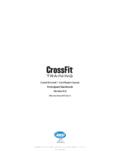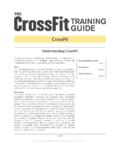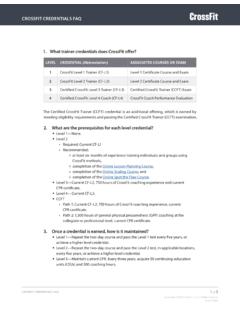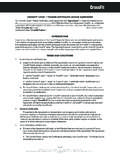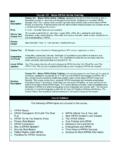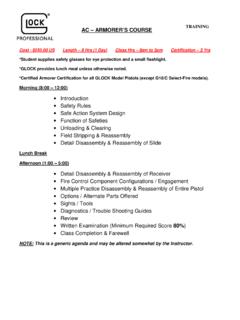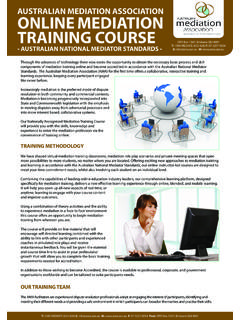Transcription of CROSSFIT SPECIALTY COURSE: KIDS TRAINING UIDE
1 CROSSFIT SPECIALTY course : KIDS. TRAINING GUIDE. Copyright 2018 CROSSFIT , Inc. All Rights Reserved. CROSSFIT is a registered trademark of CROSSFIT , Inc. All content herein is Copyright 2018 CROSSFIT , Inc. No content, in part or in whole, may be reproduced without prior written consent from CROSSFIT , Inc. CROSSFIT SPECIALTY course : Kids : TRAINING Guide |. TABLE OF CONTENTS. METHODOLOGY .. 3. CROSSFIT Kids Science .. 3. Optimizing the Child's Learning Environment .. 36. CROSSFIT Kids Nutrition and Lifestyle.. 57. Resources.. 68. Recipes .. 70. Protecting CROSSFIT Kids From Predation .. 108. MOVEMENTS .. 115. Squat.. 116. Front Squat.. 118. Overhead Squat.. 120. Press.. 122. Thruster.. 124. Push Press.. 126. Push Jerk.. 128. Deadlift .. 130. Sumo Deadlift High Pull .. 132. Hang Power Clean .. 134. Pull-Up, Push-Up, And Handstand Push-Up.. 136. POST- course RESOURCES.. 142. Kid Safety .. 142. Class Structure.. 144. Equipment List.
2 148. Affiliation.. 150. Frequently Asked Questions.. 151. Business Essential Resources .. 159. 2 of 163. Copyright 2018 CROSSFIT , Inc. All Rights Reserved. CROSSFIT is a registered trademark of CROSSFIT , Inc. Methodology: CROSSFIT Kids Science TRAINING Guide |. CROSSFIT SPECIALTY course : Kids : CROSSFIT KIDS SCIENCE. Introduction Since its inception in 2006, CROSSFIT Kids has understood the importance of having pub- lished research support and affect the program. Research from such disparate fields of study as behavioral science to molecular biology provides not only the core framework for what and how aspects of the program are implemented but more importantly, why. The references and information that follow are included for several reasons. First and fore- most, this section provides many avenues for CROSSFIT Kids Trainers to further their educa- tion. The topics presented here are merely a first step and not intended to be exhaustive.
3 The journey to become the most qualified trainer possible never ends; you can always benefit from gaining more experience and knowledge. Secondly, supporting literature is valuable when discussing the CROSSFIT Kids program with parents. There is no greater responsibility than being entrusted with another's child; having external studies to support your program can instill an additional level of confidence from them as well as with you, the trainer. Finally, for those who desire to bring CROSSFIT Kids into specific schools or districts, this information may be the basis for a presentation to principals or superintendents in support of potential benefits and efficacy. Highly Recommended Reading Lee, T. D., Swanson, L. R. & Hall, A. L. What is repeated in a repetition? Effects of practice conditions on motor skill acquisition. Phys Ther 71, 150 156 (1991). Lieberman, D. The Story of the Human Body: Evolution, Health, and Disease.
4 Pantheon (2013). ISBN-13: 978-0307379412. Lloyd, R. S. et al. Position statement on youth resistance TRAINING : the 2014 International Consensus. British Journal of Sports Medicine (2013). Medina, J. (2008) Brain Rules. Pear Press. ISBN-13: 978-0-9797777-4-5. Ratey, J. (2008) Spark. Little, Brown and Company. ISBN-13: 978-0316113502. Skerry, T. M. Mechanical loading and bone: what sort of exercise is beneficial to the skele- ton? Bone 20, 179 181 (1997). Smith, P. F., Darlington, C. L. & Zheng, Y. Move it or lose it--is stimulation of the vestibular system necessary for normal spatial memory? Hippocampus 20, 36 43 (2010). Tomporowski, P. D., Davis, C. L., Miller, P. H. & Naglieri, J. A. Exercise and Children's Intelligence, Cognition, and Academic Achievement. Educational Psychology Review 20, 111 131 (2008). Whitehead 1, M. The concept of physical literacy. European Journal of Physical Education 6, 127 138 (2001). 3 of 163. Copyright 2018 CROSSFIT , Inc.
5 All Rights Reserved. CROSSFIT is a registered trademark of CROSSFIT , Inc. Methodology: CROSSFIT Kids Science TRAINING Guide |. CROSSFIT SPECIALTY course : Kids : A Prescription To Improve Health As an organism, humans are accustomed to a very different lifestyle (1). In prehistory, the diet of our ancestors was extremely varied and movement was a necessity (hunter-gath- erers walked 5 9 miles per day)(2). As the Agricultural Revolution spread across the globe (~10,000 years ago), the diet of our species became more restricted. Foods that were grown became the staples; whereas diversity decreased, quantity and accessibility increased. Homo sapiens of this time period may have walked less, however they still worked quite hard to tend to their crops (2). Fast forward to the Industrial Revolution (~250 years ago), when food variety decreased even further as did the variety of activities in daily jobs (2). Today the variety of our diets is very restricted and we walk less than miles per day, quite a change!
6 Food products today generally contain more refined sugar and less fiber, leading to an increased insulin response and caloric uptake (2). The resulting metabolic perturba- tion has implications for the obesity epidemic (3). Obesity is a result of a mismatch between the environmental conditions we evolved in over the course of the vast majority of our history and the conditions and behaviors of today;. resulting in what Lieberman (2) calls dysevolution. Dysevolution refers to the lifestyle we pass on culturally, to subsequent generations (2). Because these are not genetic changes they can be affected by compensatory changes in environment and behavior. CROSSFIT is one component of how to change the behaviors of adults, in an attempt to reverse our maladaptation to our current circumstances. The goal of CROSSFIT Kids is to break the cycle of passing on poor behaviors, by instilling in this and future generations of children a positive association with exercise, a desire to be fit, and a goal to live a long healthy life.
7 The need to achieve this goal becomes clear with the realization that within the United States, the prevalence of individuals 2 19 years old who had body mass index measure- ments at or above the 95th percentile for their age and gender was in 2012 (4, 20, 21). Obesity engenders additional near-term morbidities such as: hyperinsulinemia, glucose intolerance, type 2 diabetes, sleep apnea, and depression (5,21). In the long term there is an increased risk of obesity as an adult, heart disease, cancer, and osteoarthritis (5,21). The acute nature of this problem is represented by the fact that childhood obesity has more than doubled in children and quadrupled in adolescents in the past 30 years (21). Children being overweight and obese is not only a problem within the United States, but also globally. Worldwide, in the period 1990 2010, there was a relative increase of 21% (first decade) and 31% (second decade) in the prevalence of early childhood overweight and obe- sity, whereas the forecast for the relative increase in the coming decade (2010 2020) is 36%.
8 Fifty-three of the 111 countries with trend data show a rising trend (6). The actual numbers are staggering, in 2010 43 million children throughout the world were overweight or obese;. more than 80% were from third-world countries (6). The rapid increase in the prevalence of this condition, especially within the most recent gen- erations, suggests that genetic factors are not the primary cause (5,7). Changes in lifestyle appear to be an instrumental factor (8). Sedentary behavior is a contributing factor to the decline of health indicators in children (9) and adults (10). This association of behavior and 4 of 163. Copyright 2018 CROSSFIT , Inc. All Rights Reserved. CROSSFIT is a registered trademark of CROSSFIT , Inc. Methodology: CROSSFIT Kids Science TRAINING Guide |. CROSSFIT SPECIALTY course : Kids : outcome is made even more troubling from the observation that the percentage of 9th to 12th graders undergoing daily physical education in US schools has declined from 42% to 27% (1991 1997) (7).
9 However, the increase in sedentary behaviors emerge well before high school; recent epidemiological reports indicate that contemporary youth are not as active as they used to be, and this decline in physical activity seems to emerge by age 6 (11). This shift in activity patterns has led to the coining of the term Exercise Deficit Disorder (11,12) in order to begin to establish the parameters to monitor and confirm the best methods of inter- vention; as well as train the personnel within society that can effect change (7,11,12,13,14). CROSSFIT Kids is composed of elements designed to reduce Exercise Deficit Disorder and poor lifestyle choices: laying foundational movement patterns, providing children with a portion of their prescribed amount of exercise for the week, improving muscular fitness, engineering endless opportunities for success, and discussing roles for food all while keeping the class and its information fun and engaging (14,15,16).
10 As an infinitely scalable program CROSSFIT Kids can also bring the benefits of physical activity to disadvantaged pop- ulations (17,18,19). Cited Sources 1. Miller, J. C. & Colagiuri, S. The carnivore connection: dietary carbohydrate in the evolu- tion of NIDDM. Diabetologia 37, 1280 1286 (1994). 2. Lieberman, D. The Story of the Human Body: Evolution, Health, and Disease. Pantheon (2013). ISBN-13: 978-0307379412. 3. Wells, J. C. K. & Siervo, M. Obesity and energy balance: is the tail wagging the dog? Eur J. Clin Nutr 65, 1173 1189 (2011). 4. Ogden CL, Carroll MD, Kit BK, Flegal KM. Prevalence of Childhood and Adult Obesity in the United States, 2011-2012. JAMA. 2014;311(8):806-814. 5. Lobstein, T., Baur, L., Uauy, R. IASO International Obesity TaskForce. Obesity in children and young people: a crisis in public health. Obesity Reviews 5 Suppl 1, 4 104 (2004). 6. de Onis, M., Bl ssner, M. & Borghi, E. Global prevalence and trends of overweight and obesity among preschool children.
